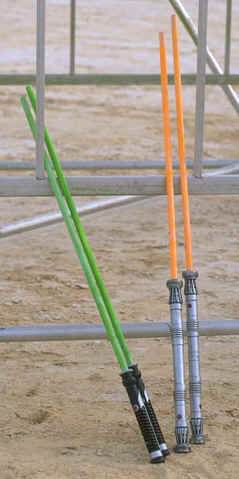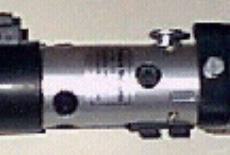 Frequently Asked QuestionsHere I’ve answered the most typically asked questions that show up in my inbox.
This is a “nonfunctional” saber. (The technology does not exist yet to produce a functional one.) I built this because I wanted to have a realistic looking light saber hilt prop to wear with my Jedi costume. Will you please build me or sell me a light saber? For the time being, no. It wasn’t my aim to sell light sabers, just show people how they can build their own (as the title of the site suggests). Do you have someone who is good at building things who could help you build yours? You’d get more enjoyment out of that anyway, I would think. However, if you are still desperate to have me build you one, I’ll add you to a list of similar requests. We are working with another team to provide assembled sabers, but it will be a while before it is finished. What
does the light inside do? The light inside it is used to illuminate the “calculator bubbles” on the handle, and to shine through the electron tube. The light is cool-looking, but would not be confused with a real light saber blade (if such existed). Essentially, you could think of it as a low-powered flashlight. Where
can I get a real/functional light saber? Remember that the technology to make a light saber does not yet exist. Even in the films, saber props were constructed using aluminum rods for blades, and the glowing light effect was added later by Industrial Light & Magic. (See Lynne’s Diary: The Making of Episode I, Part 6—Prime of the Jedi at the official Star Wars site for more detail.)
Qui-Gon Jinn and Maul Sabers, as used during filming (Photo courtesy of LucasFilms, © 1999) If you want a “functional” saber, you could build this, and build a “blade” that goes in the top. Some guys I met had sabers that used blades made from a long section of PVC pipe, about 1" in diameter, that they’d painted bright red or green—it looked pretty good. Such a blade could be inserted into the top of this design for battling. (I will probably modify my saber design to allow for using such a “blade” myself.) See also the “Noodle Saber” page. The light saber toys (about $22) are also pretty good, and even have sound effects, if you can live with the fact that the blades don’t completely disappear, and they are not extremely durable. Both my sons have them and like them quite a bit. There’s also a new $10 model that does not have sound effects, but does light up, and the blade retracts completely into the handle. We hope to offer the parts soon for a reasonable price, but the best place currently to get a plasma tube is unquestionably from Information Unlimited. They offer everything from the basic parts to an assembled kit, and for the parts, their prices are extremely reasonable—far better than I’ve seen anywhere else on the Web. If you have lots of money (upwards of $275), you can get a “plasma saber”—these use a gas-filled tube with high-frequency electricity flowing through it (something like a fluorescent light) to create a glowing “blade” effect. You can find these at Sci-Fi Collectibles, but they are expensive. The plasma sword itself could probably fairly easily be fitted to my hilt design. I’ve also found at FutureHorizons something which seems to be a similar design for less money. It turns out it’s a plasma tube mounted onto the existing “toy” sabers. See the specific FutureHorizons information below. If you have loads of money (and I mean loads), and want the best saber replica and plasma tube money can buy, you’ll want to talk to these guys at the University of Chicago. They also have some good technical information about plasma sabers. Brett “BJ” Powers suggests cannibalizing a toy saber for its blade:
Where can I get a Jedi costume? See the links page under the “Other Star Wars Sites” section. A talented woman named Juana Quinlan made costumes for my boys and I, and I’ve found one other site that sells Jedi robes. How long does it take to assemble a saber? I spent about two weeks putting my saber together. You could probably build one in one “marathon” weekend; spending most of Saturday and part of a Sunday to finish it. Remember that anything you paint will need to dry for at least 24 hours, and if you give it two coats (recommended), you’ll be adding a few minutes of work for reassembly on a third day. What about those cool sound effects? I haven’t thought much about the sound. Theoretically, you could destroy one of the toy sabers and use its sound electronics. See CTLaw74’s Project Graphlex section, under Electronics Exploded View and Electronics Photos for more information. There is also a microchip you can buy at Radio Shack that would allow you to record the light saber “hum” onto it and play it back. I just use my imagination. Padme suggests this easy-and-inexpensive method of providing sound:
How can I get these pages to print better? Some browsers have trouble with printing white text on a black background. If you are using Microsoft Internet Explorer, Click View —> Internet Options, and then click on the Advanced tab. Scroll down to the Printing settings, and be sure the box marked “Print background colors and images” is unchecked. Internet Explorer will then print black text instead of white. If you are using Netscape Navigator, go to the Preferences dialog (Edit —> Preferences), and click on Colors. Set your text and background colors to something that will print well (the default is fine), and put a check the box marked “Always use my colors, overriding document.” That will change the colors you see on screen, and allow you to print without difficulty. FutureHorizons Sabers Explained Please see my comments after this, but here is what FutureHorizons.net has to say about its sabers (thanks to Jedi Phaleg for providing this):
From Jedi Wilcox: I’ve discovered why their saber looks so much like the film sabers. They’ve cannibalized the toy sabers to make the hilt—a good idea, to a certain extent. If you look at their photo (below) of the Vader saber, you can even see the caution label on the side that says “don’t poke someone with this.” That also explains how they’re doing the sound—they’re using the existing sound hardware from the toy. Smart from a design standpoint. It also gives them a number of rather good features for a $22 investment—and probably sidesteps a number of legal issues.
I finally received a report from someone who purchased a saber from Future Horizons. You may want to e-mail him with specific questions about their sabers. I got my lightsaber today, after 6 and a half weeks. I got the Qui-Gon one, so I didn’t have a choice in blade color, it was green. It came in two pieces, the blade and the hilt. The hilt is indeed the toy ones. It even has “Hasbro” printed on the hilt. The lightsaber takes one 9 volt and 2 AAA batteries for the 24 inch blade, and I have heard that the 36 inch blade takes two 9 volt batteries. After putting the batteries in their cases, I placed them into the hollow handle, screwed on the blade, turned it on, and heard sounds but no light. I found the instructions, and they said to put the top battery pack facing up. So I fixed that and turned it on. The blade flickered for a few seconds, then lit up completely. When I turned it off, the blade flickered again, then went out. Even though the blade is a glass tube, that is in a Plexiglas tube for protection, It still shouldn’t be used for fighting. The blade light flickers sometimes when you swing it or tilt it, but usually it stays lit. What is the purpose of the electron tube? The electron tube (Hit Ray 6X5 GT, Sovtek 6SN7, or equivalent) is used merely for aesthetic (appearance) purposes. It is not part of the electronics circuit, and will not produce a saber “blade.” The light or LED within the saber shines through the electron tube, illuminating it and its internal components. It looks fabulous as an “emitter array.” Note that if you are adding a blade to the saber, you will not need this part. Both tubes and available from The Tube Store. More information is posted on the parts list. |


